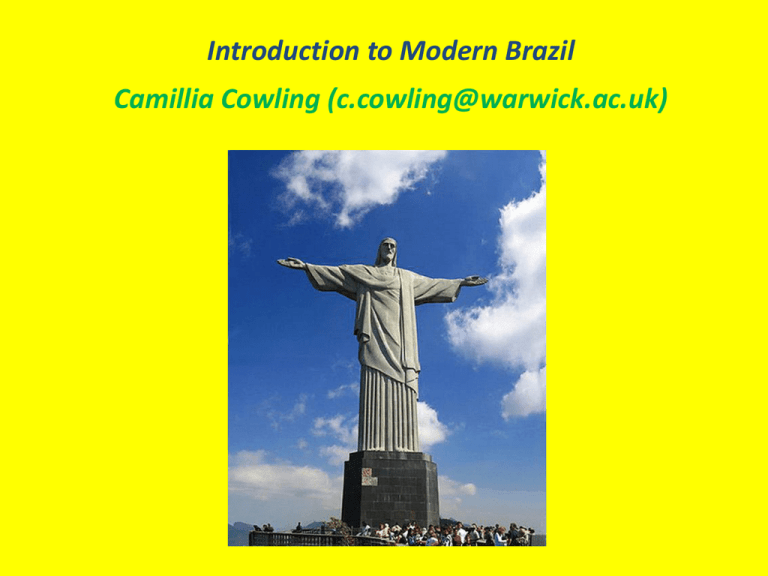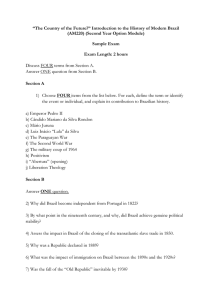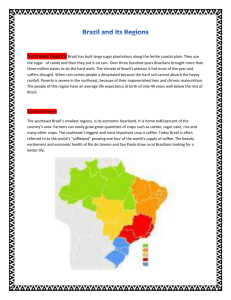Introduction to Modern Brazil Camillia Cowling ()
advertisement

Introduction to Modern Brazil Camillia Cowling (c.cowling@warwick.ac.uk) Themes in the study of Brazil • Nation-building, cultural unity despite huge size and regional diversity • Co-existence of “cordiality” and violence; extreme social inequality • Race mixture and relatively harmonious race relations; yet long history of racism • Optimism, “country of the future”; environmental questions... • Popular culture • Economy based on export products; but also more industrialization than other parts of Latin America Morumbi neighbourhood, São Paulo, with Paraíso favela next door “Discovery” and Early Administration • Major Portuguese trading empire: Azores, Madeira, Africa; Asia • 1500 Pedro Alvares de Cabral reaches N.E. Brazil • 1530s territorial consolidation (threat from European powers) • Land grants allotted by Crown • By 1570s: Crown authority on coasts, not interior; Governors General; capital city Salvador da Bahia in North-East • Seventeenth century: territorial expansion but, basic shape of colony doesn’t change • Eighteenth century: population shift south. Capital becomes Rio de Janeiro Economy: Sugar Cycle (17th century) • Portuguese already have experience growing sugar • Earliest Brazilian society is North-East sugar plantations • Indian labour unsatisfactory Africans imported • 1600-1650: Sugar provides 90-95% of Brazil’s export earnings • 1680s: Decline in productivity; Caribbean competition Economy: Eighteenth-Century Mining Cycle • Sugar declining by end of 17th century • Gold discovered 1690s in Minas Gerais; diamonds later • Brazil is world’s biggest gold producer by early eighteenth century • Shift of power, wealth, population to South-East • Mining also based on slave labour • Mining wealth goes to Portugal... an asset or a liability?? Society • Hierarchy based on race, origins, gender: white men at top, black slaves at bottom • Elite women: cloistered, subject to authority of patriarch along with servants/ minors • Miscegenation: growing sector of free people of colour; some opportunities for advancement despite prejudice • Slave society: life unthinkable without slaves; Brazil imports around 3.5 million slaves to 1850. More opportunities for manumission than in (e.g.) United States; but treatment usually harsh, life expectancy low Brazil by 1750 • Powerful local families (seeds of future oligarchies) dominate local affairs but also linked closely to Portugal • No universities or printing press, although development of some seeds of “Brazilian” culture & identity • Brazil has become richer & more important than mother country: “Without Brazil, Portugal is an insignificant power.” Portuguese solutions • Series of reforms implemented by 3 men: • 1: Sebastião José de Carvalho e Melo (Marquis of Pombal) 1750-1770 • 2: Martinho de Melo e Castro, 1770-95 • 3: Rodrigo de Sousa Coutinho, 1796-1803 • “Enlightened despotism” • Mercantilism Pombaline Reforms • ADMINISTRATIVE: state of Grão-Pará & Maranhão integrated into one Estado do Brasil ruled from Rio de Janeiro • TRADE: monopoly trading companies replace old fleet system of trading • ECONOMY / PRODUCTION: stimulate production of Brazilian agricultural products and demand for Portuguese manufactures • RELIGIOUS: Expulsion of Jesuits 1759 Results of reforms • General economic recovery for Brazil and Portugal by 1790s • Coffee exported from Brazil for first time; sugar recovers; new products: rice, wheat, indigo... • Portugal’s trade deficit reduced by 70%, 17511775 • Brazil supplies 61% of Portugal’s trade surplus: dependence on Brazil increases Tensions in late eighteenth century • Material resentments: tax increases; dominance of Portuguese merchants; growing anti-Portuguese sentiment; awareness of Brazil’s greater economic power • Influence of Enlightenment ideas among elite (via Coimbra) . Influence of Enlightenmentinspired revolutions: United States; France



